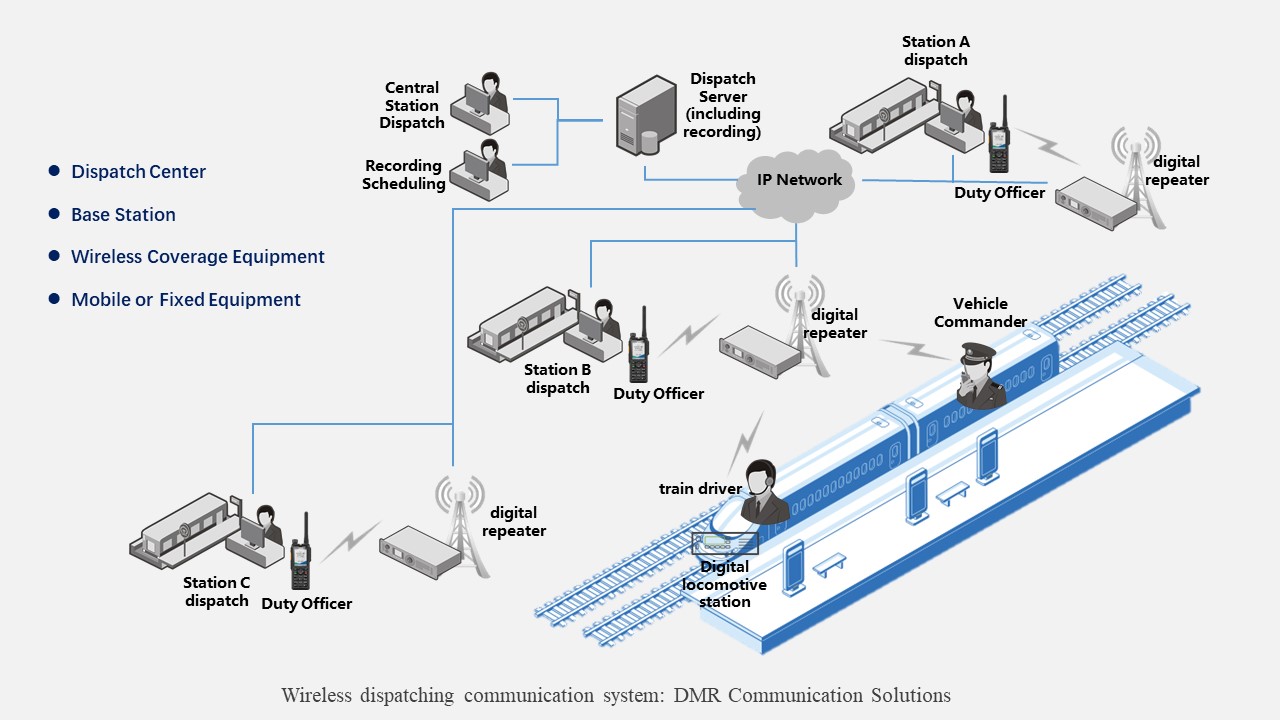Wireless Dispatching Communication System Review of Railway 400MHz Train(Example of China)
Two-way Radio
Wireless dispatching communication of Train plays a vital role in ensuring railway safety and operational efficiency.
Currently many existing branch lines and local dedicated railways still rely on 450MHz analog wireless train dispatch systems, which are with problem of low frequency resource utilization, poor anti-interference capability, and other limitations. These systems can no longer adequately meet the demands of modern train operations.
According to the "Letter No. 260 [2023] from the Ministry of Industry and Information Technology (MIIT)" – Letter from the Ministry of Industry and Information Technology on Delegating National Railway about Administration of Radio Frequency Licensing Usage – the originally dedicated 450MHz frequency band for railways will be reclaimed. Existing analog train dispatch communication systems must transfer to digital systems, which is required to be completed by the end of 2028.
For branch and dedicated lines, adopting 5G-R or GSM-R systems involves challenges like high construction costs and long deployment cycle. Additionally, these lines often have lower classification standards and lower traffic density. Therefore, there is a need for a 400MHz digital wireless train dispatch system solution that provides essential train command functions, lower costs, shorter deployment time, and easier maintenance.
As a leading domestic manufacturer of 400MHz wireless communication equipment, Hytera has been fully involved in the technical proposal for the digital train dispatch system put forward by China State Railway Group. Having deeply studied the business requirements and functional aspects, based on extensive expertise in 400MHz digital wireless communications, Hytera has developed a comprehensive 400MHz digital wireless communications suitable for conventional railways, branch lines, and dedicated local lines.
Demand for digital wireless communication services on railways
Wireless Train Dispatch Communication
The communication modes of wireless train dispatch services mainly include individual calls and group calls. The service occurs between trains and ground users, primarily involving the following users:
a) Fixed terminals: including dispatch consoles and station consoles;
b) Mobile terminals: including Cab Integrated Radio (CIR) and train dispatch two-way radio devices.
Dispatch Command Information
Wireless transmission of dispatch command information refers to the exchange of data between train dispatchers, station attendants, and train drivers, including wireless operational dispatch commands, train route previews, shunting operation notices, as well as locomotive confirmation messages.
The communication mode for this service is primarily point-to-point data transmission. The service occurs between trains and ground users, mainly involving the following equipment:
a) Cab Integrated Radio (CIR);
b) TDCS/CTC equipment.
Train Number Verification Information
This service primarily employs a point-to-point data transmission mode, enabling the exchange of information—including train numbers, locomotive numbers, location data, and train start/stop status—between the Cab Integrated Radio (CIR) and the TDCS/CTC systems.
Operation and Maintenance
This includes two main parts: maintenance and repair operations, and in-transit monitoring information transmission.
Maintenance and repair operations involve voice communication between on-site protection personnel, station liaison personnel, operation persons, and ground maintenance dispatch commanders.
In-transit monitoring information transmission refers to the process of sending key status and location data—such as that from the Cab Integrated Radio (CIR) on locomotives and self-propelled special equipment—to the Remote Monitoring System (RMS).
Hytera Digital Integrated Wireless Communication System of 400MHz Railway

Main System Functions:
- Major Triangle Communication (Train Dispatch, Station Attendant, Locomotive Driver)
- Minor Triangle Communication (Station Attendant, Locomotive Driver, Train Conductor)
- Emergency Call (Dispatch Console Interrupts Terminal Call)
- Mobile Terminal Login/Logoff Information
- Handover
- Real-Time Display of Locomotive GPS Position (When GPS Signal is Available)
- Recording Storage and Playback
- Signaling Storage and Playback
- Locomotive Dispatch Order Issuance and Order Record Query
- Equipment Monitoring
- Other Communication Services (Permanent Way, Signaling & Telecommunications, Logistics Support)
Main Communication Equipment of the System
1. Base Station TR980
- Supports analog and digital operation modes, switchable manually or via secondary development interfaces;
- In analog mode, complies with Section 5.4 of GB/T 28792-2012 and used with fixed stations;
- In digital mode, supports key voice (including individual calls and group calls) and data functions as specified in System A services under Section 6.2.8 of GB/T 32659-2016;
- In digital mode, supports dual-slot transmit and receive on the same frequency, enabling simultaneous transmission, simultaneous reception, and transmit/receive operation;
- In digital mode, supports forced stop-and-release functionality. Preferably using embedded RC reverse signaling, the base station can be controlled via secondary development interfaces to send RC reverse signaling, forcing mobile terminals occupying uplink channel resources to stop transmission and release resources;
- In digital mode, supports sending SLC (Signaling Link Code) via CACH(Common Announcement Channel);
- In digital mode, supports native color code courtesy function, color code query, and configuration;
- In digital mode, supports real-time notification, query, and configuration of the AT bit status in CACH bursts. The AT bit status is automatically set to "busy" only when uplink data with a matching color code is received.
2. Vehicle-mounted two-way radio TM650
- Supports analog and digital operation modes, switchable manually or via secondary development interfaces;
- In analog mode, complies with Section 5.5 of GB/T 28792-2012 when used with CIR (Cab Integrated Radio);
- In digital mode, supports key voice (including individual calls and group calls) and data functions as specified in System A services under Section 6.2.8 of GB/T 32659-2016;
- In digital mode, preferably supports dual-slot simultaneous reception on the same frequency, enabling concurrent reception of voice and data information;
- In digital mode, preferably supports forced stop-and-release functionality based on embedded RC reverse signaling. While transmitting on one timeslot, it can receive RC reverse forced stop-and-release commands on another timeslot to terminate the current transmission;
- In digital mode, while in receive or idle state, supports the ability to receive SLC signaling via CACH;
- In digital mode, supports native color code courtesy function, color code query, and configuration;
- In digital mode, supports real-time notification and query of the AT bit status in CACH bursts. Transmission is prohibited only when the received AT bit status is "busy."
3. Specialized Train Dispatch Handheld Terminal TP530L
- Supports analog and digital operation modes, switchable manually;
- In analog mode, supports calling and communication functions as specified in GB/T 28792-2012, including Push-to-Talk (PTT) functionality;
- In digital mode, supports individual voice calls, group voice calls, and data services;
- In digital mode, features terminal identification during voice communication;
- In digital mode, preferably supports forced stop-and-release (RC) functionality and can receive SLC signaling via the Common Announcement Channel (CACH);
- Equipped with call recording functionality;
- Supports time query and calibration;
- In digital mode, supports native color code courtesy function, capable of identifying the color code of the attached fixed station and dynamically configuring it;
- In digital mode, transmission is prohibited only when the received AT bit status is "busy";
- Features one-key voice alarm functionality, with support for user-customizable alarm prompt messages.
References
1.General Technical Requirements for Train Digital Wireless Dispatch Communication System (Interim) (Tie Gong Dian [2023] No. 33)
2.Trial Evaluation Outline for Railway 400MHz Digital Wireless Train-Service Dispatch System
3.Q/CR 980-2023 Railway Specific Digital Two-Way Radio Equipment
4.MIIT Letter [2023] No. 260: Letter from the Ministry of Industry and Information Technology on Delegating National Railway about Administration of Radio Frequency Licensing Usage






